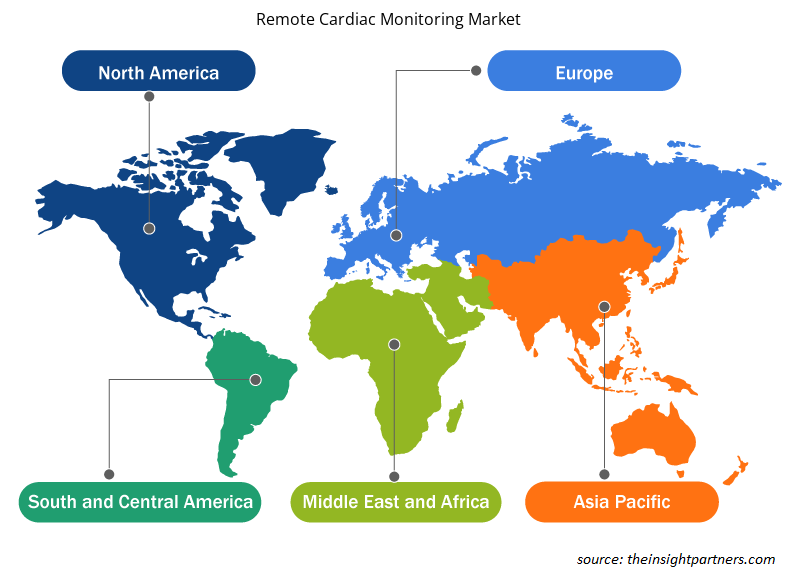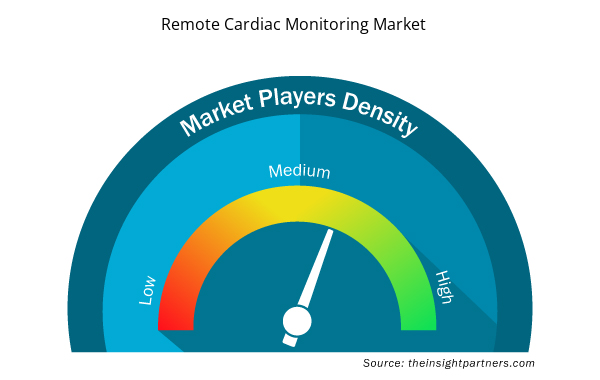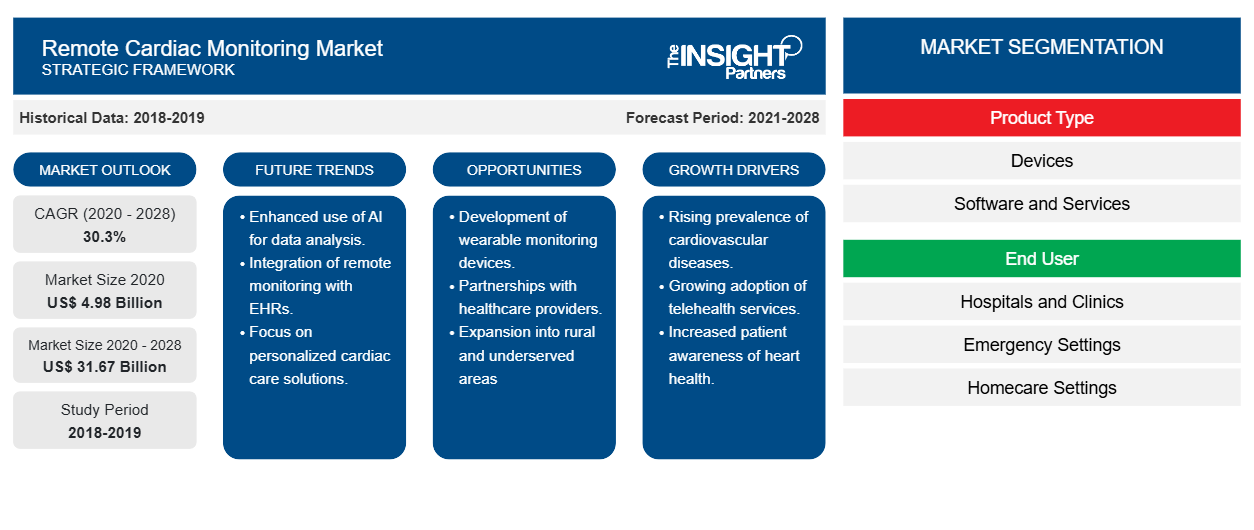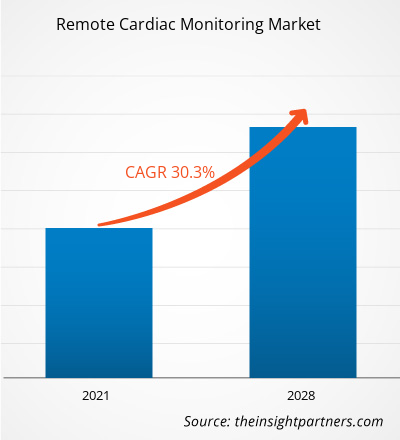Si prevede che il mercato del monitoraggio cardiaco remoto raggiungerà i 31.671,69 milioni di dollari entro il 2028, rispetto ai 4.976,40 milioni di dollari del 2021; si stima che crescerà a un CAGR del 30,3% dal 2021 al 2028.CAGR of 30.3% from 2021 to 2028.
I dispositivi di monitoraggio cardiaco remoto consentono un monitoraggio continuo delle attività elettriche del cuore lontano dagli ospedali. Consentono inoltre il monitoraggio elettrocardiografico (ECG) a domicilio di pazienti con sospette aritmie cardiache o a rischio di sviluppare aritmie. Il monitoraggio può essere eseguito anche quando i pazienti sono immersi nelle loro attività quotidiane. Pertanto, uno dei vantaggi più importanti del monitoraggio cardiaco remoto è che riduce la necessità di visite mediche di routine. Dispositivi come pacemaker e defibrillatori cardioverter impiantabili vengono impiantati nel cuore dei pazienti tramite procedure minimamente invasive. Un trasmettitore che funziona in sincronia con il dispositivo esegue la trasmissione dei dati. Fattori come l'aumento dell'incidenza delle malattie cardiovascolari (CVD) e i continui sviluppi nell'approccio della telemedicina stimolano la crescita del mercato del monitoraggio cardiaco remoto . Tuttavia, le preoccupazioni relative alla privacy dei dati ostacolano la crescita del mercato.electrocardiographic (ECG) monitoring of patients with suspected cardiac arrhythmias or at risk for developing arrhythmias. The monitoring can also be performed when patients are engulfed in their day-to-day activities. Thus, one of the most important benefits of remote cardiac device monitoring is it decreases the need for routine doctor visits. Devices such as pacemakers and implantable cardioverter-defibrillator are implanted in the heart of the patients through minimally invasive procedures. A transmitter that works in sync with the device undertakes the transmission of data. Factors such as increase in the incidence of cardiovascular diseases (CVDs) and continuous developments in the telemedicine approach boost the growth of the
Personalizza questo report in base alle tue esigenze
Riceverai la personalizzazione gratuita di qualsiasi report, comprese parti di questo report, o analisi a livello nazionale, pacchetto dati Excel, oltre a usufruire di grandi offerte e sconti per start-up e università
- Scopri le principali tendenze di mercato in questo rapporto.Questo campione GRATUITO includerà analisi di dati che spaziano dalle tendenze di mercato alle stime e alle previsioni.
Approfondimenti di mercato
Aumento dell'incidenza delle malattie cardiovascolari
Il monitoraggio remoto dei pazienti (RPM) consente ai pazienti di gestire meglio la propria salute aumentando il loro coinvolgimento nell'assistenza sanitaria. L'American Heart Association supporta iniziative per incentivare la progettazione e l'uso di tecnologie di monitoraggio remoto dei pazienti basate sulle prove. Secondo l'Organizzazione mondiale della sanità (OMS), le malattie cardiovascolari (CVD) sono tra le principali cause di morte in tutto il mondo e circa 30 milioni di persone subiscono un ictus ogni anno. Secondo l'American Heart Association, quasi la metà di tutti gli adulti negli Stati Uniti ha un tipo di CVD. Inoltre, si prevede che più di 130 milioni di persone, ovvero il 45,1% della popolazione statunitense, avranno un tipo di CVD entro il 2035. Secondo i rapporti della Società europea di cardiologia, le CVD causano 3,9 milioni di decessi in Europa e oltre 1,8 milioni di decessi nell'Unione europea (UE). Inoltre, rappresentano il 45% di tutti i decessi in Europa e il 37% dei decessi totali nell'UE. La mortalità causata da CVD nei paesi dell'Asia-Pacifico varia da meno del 20% in paesi come Thailandia, Filippine e Indonesia al 20-30% nella Cina urbana, Hong Kong, Giappone, Corea e Malesia. Inoltre, Nuova Zelanda, Australia e Singapore, tra gli altri, hanno tassi relativamente alti del 30-35%.incentivize the design and use of evidence-based remote patient monitoring technologies. According to the World Health Organization (WHO), cardiovascular diseases (CVDs) are among the leading causes of death worldwide, and ~30 million people experience a stroke each year. According to the American Heart Association, almost half of all adults in the US have a type of CVD. Furthermore, more than 130 million people, i.e., 45.1% of the US population, are projected to have a type of CVD by 2035. According to reports by the European Society of Cardiology, CVDs cause 3.9 million deaths in Europe and over 1.8 million deaths in the European Union (EU). Moreover, they account for 45% of all deaths in Europe and 37% of total deaths in the EU. Mortalities caused by CVDs in the Asia-Pacific countries range from less than 20% in countries such as Thailand, the Philippines, and Indonesia to 20–30% in urban China, Hong Kong, Japan, Korea, and Malaysia. Furthermore, New Zealand, Australia, and Singapore, among others, have relatively high rates of 30–35%.
L'ipertensione è un fattore di rischio significativo per le malattie cardiovascolari. La prevalenza di ipertensione aggiustata per età tra gli adulti negli Stati Uniti è di circa il 35%, pari a una popolazione di circa 85 milioni. Entro il 2035, circa il 42% degli adulti del paese, ovvero altri 27 milioni, soffrirà di questa condizione. Anche l'onere dei costi dell'ipertensione sulle economie è in aumento e i costi probabilmente saliranno da circa 70 miliardi di $ USA nel 2015 a circa 150 miliardi di $ USA entro il 2035. Il monitoraggio remoto dei pazienti può fungere da canale vitale per migliorare il controllo dell'ipertensione e ridurre l'onere economico derivante da ricoveri ospedalieri prolungati o frequenti che derivano da eventi acuti correlati all'ipertensione. La ricerca ha dimostrato che (Remote Patient Monitoring) RPM può abbassare significativamente la pressione sanguigna sistolica (SBP) e la pressione sanguigna diastolica (DBP) rispetto alle cure abituali e all'automonitoraggio da soli. Secondo alcuni studi non randomizzati, i dispositivi RPM possono migliorare i risultati consentendo una rilevazione accurata e precoce, nonché riducendo i tassi di mortalità per tutte le cause e i ricoveri ospedalieri. Le recenti linee guida cliniche raccomandano fortemente l'uso di RPM per la rilevazione della fibrillazione atriale (FA) sia nei pazienti con ictus che in quelli senza ictus.
Informazioni basate sul tipo di prodotto
In base al tipo di prodotto, il mercato del monitoraggio cardiaco remoto è ulteriormente segmentato in dispositivi, software e servizi. Il segmento dei dispositivi ha detenuto una quota di mercato maggiore nel 2021 e si prevede che registrerà un CAGR più elevato durante il periodo di previsione.
Informazioni basate sull'utente finale
In base all'utente finale, il mercato del monitoraggio cardiaco remoto è segmentato in ospedali e cliniche, contesti di emergenza, contesti di assistenza domiciliare e altri. Il segmento ospedali e cliniche deterrebbe la quota di mercato maggiore nel 2021, mentre si prevede che il mercato per il segmento dei contesti di emergenza crescerà a un CAGR del 31,60% durante il periodo di previsione.
Diverse aziende che operano nel mercato del monitoraggio cardiaco a distanza stanno adottando strategie quali lanci di prodotti, fusioni e acquisizioni, collaborazioni, innovazioni di prodotto ed espansioni del portafoglio prodotti per espandere la propria presenza in tutto il mondo, mantenere il marchio e soddisfare la crescente domanda degli utenti finali.
Approfondimenti regionali sul mercato del monitoraggio cardiaco remoto
Le tendenze regionali e i fattori che influenzano il mercato del monitoraggio cardiaco remoto durante il periodo di previsione sono stati ampiamente spiegati dagli analisti di Insight Partners. Questa sezione discute anche i segmenti del mercato del monitoraggio cardiaco remoto e la geografia in Nord America, Europa, Asia Pacifico, Medio Oriente e Africa e America meridionale e centrale.

- Ottieni i dati specifici regionali per il mercato del monitoraggio cardiaco remoto
Ambito del rapporto di mercato sul monitoraggio cardiaco remoto
| Attributo del report | Dettagli |
|---|---|
| Dimensioni del mercato nel 2020 | 4,98 miliardi di dollari USA |
| Dimensioni del mercato entro il 2028 | 31,67 miliardi di dollari USA |
| CAGR globale (2020 - 2028) | 30,3% |
| Dati storici | 2018-2019 |
| Periodo di previsione | 2021-2028 |
| Segmenti coperti | Per tipo di prodotto
|
| Regioni e Paesi coperti | America del Nord
|
| Leader di mercato e profili aziendali chiave |
|
Densità degli attori del mercato: comprendere il suo impatto sulle dinamiche aziendali
Il mercato del Remote Cardiac Monitoring Market sta crescendo rapidamente, spinto dalla crescente domanda degli utenti finali dovuta a fattori quali l'evoluzione delle preferenze dei consumatori, i progressi tecnologici e una maggiore consapevolezza dei benefici del prodotto. Con l'aumento della domanda, le aziende stanno ampliando le loro offerte, innovando per soddisfare le esigenze dei consumatori e capitalizzando sulle tendenze emergenti, il che alimenta ulteriormente la crescita del mercato.
La densità degli operatori di mercato si riferisce alla distribuzione di aziende o società che operano in un particolare mercato o settore. Indica quanti concorrenti (operatori di mercato) sono presenti in un dato spazio di mercato in relazione alle sue dimensioni o al valore di mercato totale.
Le principali aziende che operano nel mercato del monitoraggio cardiaco remoto sono:
- Sistemi OSI, Inc.
- Assistenza sanitaria GE
- Biotronica Se
- Società Nihon Kohden
- Laboratori Abbott
Disclaimer : le aziende elencate sopra non sono classificate secondo un ordine particolare.

- Ottieni una panoramica dei principali attori del mercato del monitoraggio cardiaco remoto
Mercato del monitoraggio cardiaco remoto – per tipo di prodotto
- Dispositivi
- Software
- Servizi
Mercato del monitoraggio cardiaco remoto – per utente finale
- Ospedali e Cliniche
- Impostazioni di emergenza
- Impostazioni di assistenza domiciliare
- Altri
Mercato del monitoraggio cardiaco remoto – per area geografica
- America del Nord
- NOI
- Canada
- Messico
- Europa
- Francia
- Germania
- Italia
- Regno Unito
- Spagna
- Resto d'Europa
- Asia Pacifico (APAC)
- Cina
- India
- Corea del Sud
- Giappone
- Australia
- Resto dell'Asia Pacifica
- Medio Oriente e Africa (MEA)
- Sudafrica
- Arabia Saudita
- Emirati Arabi Uniti
- Resto del Medio Oriente e Africa
- America del Sud e Centro (TRUFFA)
- Brasile
- Argentina
- Resto del Sud e Centro America
Profili aziendali
- Sistemi OSI, Inc.
- Assistenza sanitaria GE
- Biotronica Se
- Società Nihon Kohden
- Laboratori Abbott
- Società scientifica di Boston
- Koninklijke Philips NV
- Honeywell International, Inc.
- Salute AMC
- Analisi storica (2 anni), anno base, previsione (7 anni) con CAGR
- Analisi PEST e SWOT
- Valore/volume delle dimensioni del mercato - Globale, regionale, nazionale
- Industria e panorama competitivo
- Set di dati Excel



Report Coverage
Revenue forecast, Company Analysis, Industry landscape, Growth factors, and Trends

Segment Covered
This text is related
to segments covered.

Regional Scope
North America, Europe, Asia Pacific, Middle East & Africa, South & Central America

Country Scope
This text is related
to country scope.
Domande frequenti
Global remote cardiac monitoring market is segmented by region into North America, Europe, Asia Pacific, Middle East & Africa and South & Central America. In North America, the U.S. is the largest market for remote cardiac monitoring. The US is estimated to hold the largest share in the remote cardiac monitoring market during the forecast period. The growth of the market can be because of the rising investments in cardiology informatics, connected devices, and mobile solutions for advanced cardiac care, increasing product launches, and R&D activities to develop advanced remote cardiac monitoring devices. In addition, technologically advanced products are likely to stimulate the growth of remote cardiac monitoring market in North America. On the other hand, growing emphasis on cost optimization, focus on streamlining of clinical processes, increasing number of clinical trials, rise in the government initiatives, growing number of research and development activities, and rising number of product launches and approvals in the Asia Pacific is expected to account for the fastest growth of the region during the coming years.
The remote cardiac monitoring market majorly consists of the players such OSI Systems, Inc., GE Healthcare, Biotronik Se, Nihon Kohden Corporation, Abbott Laboratories, Boston Scientific Corporation, Koninklijke Philips N.V., Honeywell International, Inc. and AMC Health among others.
The hospitals and clinics segment dominated the global remote cardiac monitoring market and accounted for the largest revenue share of 37.60% in 2021.
The device segment dominated the global remote cardiac monitoring market and held the largest revenue share of 58.53% in 2021.
Remote cardiac monitoring is the constant monitoring of electrical activities of the heart, which practices place outside hospitals. The monitoring can also be performed while the patient is doing the day-to-day activities. Devices like pacemakers and implantable cardioverter-defibrillator are placed with the patient through minimally invasive procedures. The transmission of data takes place within a transmitter that works in sync with the device. Remote cardiac monitoring technologies allow home electrocardiographic (ECG) monitoring of patients with suspected cardiac arrhythmias or at risk for developing arrhythmias. One of the most important benefits of remote cardiac device monitoring is that it cuts down on routine doctor visits. Without remote monitoring, patients visited the doctor every three to six months (depending on device type) for a data download. With remote monitoring, the number of visits have dropped to one to two per year. Remote cardiac device monitoring is a fantastic way to follow patients and it has always been important, but it’s especially important in this era of COVID-19.
Key factors that are driving the growth of this market are increase in incidence of cardiovascular diseases, continuous developments in telemedicine approach, and rising investment in research and development are expected to boost the market growth for the remote cardiac monitoring over the years.
Trends and growth analysis reports related to Life Sciences : READ MORE..
The List of Companies - Remote Cardiac Monitoring Market
- OSI Systems, Inc.
- GE Healthcare
- Biotronik Se
- Nihon Kohden Corporation
- Abbott Laboratories
- Boston Scientific Corporation
- Koninklijke Philips N.V.
- Honeywell International, Inc.
- AMC Health
The Insight Partners performs research in 4 major stages: Data Collection & Secondary Research, Primary Research, Data Analysis and Data Triangulation & Final Review.
- Data Collection and Secondary Research:
As a market research and consulting firm operating from a decade, we have published and advised several client across the globe. First step for any study will start with an assessment of currently available data and insights from existing reports. Further, historical and current market information is collected from Investor Presentations, Annual Reports, SEC Filings, etc., and other information related to company’s performance and market positioning are gathered from Paid Databases (Factiva, Hoovers, and Reuters) and various other publications available in public domain.
Several associations trade associates, technical forums, institutes, societies and organization are accessed to gain technical as well as market related insights through their publications such as research papers, blogs and press releases related to the studies are referred to get cues about the market. Further, white papers, journals, magazines, and other news articles published in last 3 years are scrutinized and analyzed to understand the current market trends.
- Primary Research:
The primarily interview analysis comprise of data obtained from industry participants interview and answers to survey questions gathered by in-house primary team.
For primary research, interviews are conducted with industry experts/CEOs/Marketing Managers/VPs/Subject Matter Experts from both demand and supply side to get a 360-degree view of the market. The primary team conducts several interviews based on the complexity of the markets to understand the various market trends and dynamics which makes research more credible and precise.
A typical research interview fulfils the following functions:
- Provides first-hand information on the market size, market trends, growth trends, competitive landscape, and outlook
- Validates and strengthens in-house secondary research findings
- Develops the analysis team’s expertise and market understanding
Primary research involves email interactions and telephone interviews for each market, category, segment, and sub-segment across geographies. The participants who typically take part in such a process include, but are not limited to:
- Industry participants: VPs, business development managers, market intelligence managers and national sales managers
- Outside experts: Valuation experts, research analysts and key opinion leaders specializing in the electronics and semiconductor industry.
Below is the breakup of our primary respondents by company, designation, and region:

Once we receive the confirmation from primary research sources or primary respondents, we finalize the base year market estimation and forecast the data as per the macroeconomic and microeconomic factors assessed during data collection.
- Data Analysis:
Once data is validated through both secondary as well as primary respondents, we finalize the market estimations by hypothesis formulation and factor analysis at regional and country level.
- Macro-Economic Factor Analysis:
We analyse macroeconomic indicators such the gross domestic product (GDP), increase in the demand for goods and services across industries, technological advancement, regional economic growth, governmental policies, the influence of COVID-19, PEST analysis, and other aspects. This analysis aids in setting benchmarks for various nations/regions and approximating market splits. Additionally, the general trend of the aforementioned components aid in determining the market's development possibilities.
- Country Level Data:
Various factors that are especially aligned to the country are taken into account to determine the market size for a certain area and country, including the presence of vendors, such as headquarters and offices, the country's GDP, demand patterns, and industry growth. To comprehend the market dynamics for the nation, a number of growth variables, inhibitors, application areas, and current market trends are researched. The aforementioned elements aid in determining the country's overall market's growth potential.
- Company Profile:
The “Table of Contents” is formulated by listing and analyzing more than 25 - 30 companies operating in the market ecosystem across geographies. However, we profile only 10 companies as a standard practice in our syndicate reports. These 10 companies comprise leading, emerging, and regional players. Nonetheless, our analysis is not restricted to the 10 listed companies, we also analyze other companies present in the market to develop a holistic view and understand the prevailing trends. The “Company Profiles” section in the report covers key facts, business description, products & services, financial information, SWOT analysis, and key developments. The financial information presented is extracted from the annual reports and official documents of the publicly listed companies. Upon collecting the information for the sections of respective companies, we verify them via various primary sources and then compile the data in respective company profiles. The company level information helps us in deriving the base number as well as in forecasting the market size.
- Developing Base Number:
Aggregation of sales statistics (2020-2022) and macro-economic factor, and other secondary and primary research insights are utilized to arrive at base number and related market shares for 2022. The data gaps are identified in this step and relevant market data is analyzed, collected from paid primary interviews or databases. On finalizing the base year market size, forecasts are developed on the basis of macro-economic, industry and market growth factors and company level analysis.
- Data Triangulation and Final Review:
The market findings and base year market size calculations are validated from supply as well as demand side. Demand side validations are based on macro-economic factor analysis and benchmarks for respective regions and countries. In case of supply side validations, revenues of major companies are estimated (in case not available) based on industry benchmark, approximate number of employees, product portfolio, and primary interviews revenues are gathered. Further revenue from target product/service segment is assessed to avoid overshooting of market statistics. In case of heavy deviations between supply and demand side values, all thes steps are repeated to achieve synchronization.
We follow an iterative model, wherein we share our research findings with Subject Matter Experts (SME’s) and Key Opinion Leaders (KOLs) until consensus view of the market is not formulated – this model negates any drastic deviation in the opinions of experts. Only validated and universally acceptable research findings are quoted in our reports.
We have important check points that we use to validate our research findings – which we call – data triangulation, where we validate the information, we generate from secondary sources with primary interviews and then we re-validate with our internal data bases and Subject matter experts. This comprehensive model enables us to deliver high quality, reliable data in shortest possible time.


 Ottieni un campione gratuito per questo repot
Ottieni un campione gratuito per questo repot